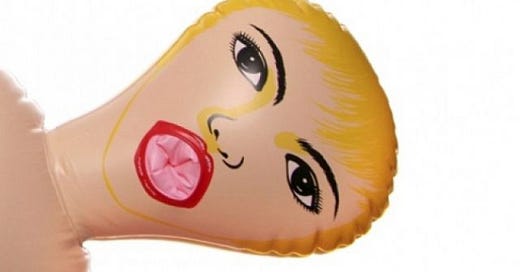On April 1, 1980, 34,000 New York City transit workers went on strike. No subways and no buses in the five boroughs. Any New Yorker knows that's quite a mess.
An edict went up from City Hall. No less than three people in a car will be allowed south of 96th St. in Manhattan between the hours of 6 a.m. and 10 a.m.
At the New York Daily News, city editor Sam Roberts came up with the idea that I should get a life-size doll or mannequin, dress it up in women's clothes, and with a photographer, drive around south of 96th St. to see if any cop or anyone at all, notices that I don't have three real people in the car.
So where do I get a doll that big or a mannequin? Roberts didn't know.
First things first, I visited the fashion section of the features department and grabbed some women's clothes their staffers had collected from somewhere. I took a pair of lady's pants, a purple sweater top, and a beret.
I recall the photographer was Tom Monaster, a great shooter with a sense of humor.
The dirty part of my mind then figured out the fastest way to get a life-size woman's doll. First stop was a sex toy shop in Times Square.
Yes, they had a blow-up doll with a bunch of apertures for customers inclined to be slightly kinky in their sex habits. Thirty bucks. Got a receipt for the expense account.
She came in a plastic bag, uninflated. Gotta blow her up like a balloon.
Monaster had the idea to drive the unmarked radio car to a deserted lot on the West Side of Manhattan, somewhere in the 30s near the West Side Highway.
I exited the car and started blowing into the doll's inflate-tube. Slowly (after what had to be about 20 minutes of huffin' and puffin'), the doll was full size.
And that's when two squad cars showed up.
Someone in some high-rise nearby had seen what I was doing and phoned in a report of a pervert in a vacant lot.
As four stupefied cops got out of their vehicles, I knew I had some explaining to do. After all, I was holding the inflated creature in my arms, all holes exposed.
I took out the press card, as did Monaster, and we told the cops to hold on, it's not what they think. I explained the assignment and smiles crossed their faces, thank God.
One of the cops took the doll and walked out onto the street. There, he held it up high and shouted to the hookers plying their trade a block away.
"Hey girls, look at your competition."
Thanks, I said, as he gave me back the doll laughing his ass off.
We quickly dressed the stupid thing in the women's duds and drove off with the blow-up babe in the driver's side passenger seat.
During a meandering trip south of 96th St., no one noticed we were driving around with a dressed-up sex toy.
I wasn't completely happy with my lead paragraph for the story. It was based on the Lerner and Lowe song, "They Called the Wind Maria."
Maria is pronounced "Mariah," because it's based on a book titled "Storm," and the author said that was the way he meant the name to be pronounced.
I wasn't sure everybody would know that. But I still took a shot and it got through the copy desk.
So the piece began, "I called her Maria, like the wind, because it took about 20 minutes of my wind to inflate her."
I wrote about the purpose of the assignment, the sex shop, inflating the damn thing, the cops goofing on me, the hookers. The piece ran as a sidebar story to the transit strike main piece.
I returned the clothes to the fashion department, deflated Maria and kept her under my desk for a while.
She ended up being the featured attraction at the bachelor party for fellow reporter Bob Lane, who asked me if he could have Maria for the soiree. He was marrying fellow reporter Sheila Sullivan.
I never did ask him what they used the doll for at his party. I do wonder if Maria is still somewhere in his closet.
The strike by the way was compounded by a walkout on the Long Island Railroad a day after the city transit workers' walkout. The trains and buses came back on April 11, the railroad the next day.
During that time, the population of Manhattan is said to have increased by 500,000 people primarily corporate employees staying in hotel rooms.
Bicycle commuters grew by 200,000 people. Women commuters switched to wearing athletic sneakers to trudge through Manhattan streets. They were dubbed the "sneaker brigade."
During the strike, the city lost approximately $2 million a day in taxes and another $1 million a day in overtime expenses for city employees.
Companies in the private sector lost some $100 million per day, on top of a total of $75 million to $100 million of lost income. Job absenteeism was estimated to be between 15 and 20 percent.
After the strike, NYC transit fares were increased from 50 cents to 60 cents. God, that's a million years ago.
I don't know if there was an increase in the sales of blow-up sex dolls.




I think Kappy has her nowadays.
And shortly after that, Russell Baker penned one of my favorite columns: https://www.nytimes.com/1981/04/29/opinion/observer-and-only-sixty-cents.html